

68 Circular Road, #02-01 049422, Singapore
Revenue Tower, Scbd, Jakarta 12190, Indonesia
4th Floor, Pinnacle Business Park, Andheri East, Mumbai, 400093
Cinnabar Hills, Embassy Golf Links Business Park, Bengaluru, Karnataka 560071
Connect With Us
Private Jet Membership Models: A $10B Subscription Market by 2032.
The U.S. private jet membership market is forecasted to grow from $4.1B in 2025 to $10.2B by 2032, marking a CAGR of 13.8%. Demand for subscription-based aviation models is accelerating as business travelers, high-net-worth individuals (HNWIs), and corporate clients seek flexible, on-demand air mobility solutions. By 2032, over 60% of private flight bookings in the U.S. will occur through membership or fractional ownership platforms, driven by fleet digitalization, sustainability incentives, and expanding mid-tier clientele. The shift from ownership to access-based aviation signals a permanent transformation in private air travel economics.
What's Covered?
Report Summary
Key Takeaways
- Market size: $4.1B → $10.2B (CAGR 13.8%).
- 60% of private jet users to shift to subscription or membership models by 2032.
- HNWIs and corporate travelers make up 75% of total spend.
- Mid-tier memberships under $100K annually growing at 17% CAGR.
- Sustainability-driven memberships (carbon-neutral fleets) up 40% YoY.
- Digital booking platforms to represent 70% of new memberships by 2030.
- Fractional ownership programs forecast to reach $3.8B valuation.
- Fleet utilization efficiency to improve by 32% via AI scheduling.
- Hybrid air mobility firms entering market with electric VTOL integration by 2031.
- Top operators: NetJets, Wheels Up, XO, Flexjet, and Jet Linx dominate 80% of the market.
Key Metrics
Market Size & Share
The U.S. private jet membership market is set to expand from $4.1B in 2025 to $10.2B by 2032, driven by changing traveler behavior and economic accessibility. Membership-based aviation will account for 60% of total private jet usage, up from 42% in 2025. High-net-worth individuals (HNWIs) remain the dominant segment, but mid-tier professionals and corporate clients are fueling subscription expansion through tiered access programs costing $50K–$250K annually. Fractional ownership, valued at $3.8B by 2032, offers predictable cost structures, while shared seat models are emerging for semi-private flights. The market’s scalability is supported by fleet digitization, predictive maintenance, and integrated digital booking systems enhancing reliability and cost-efficiency.
Market Analysis
Between 2025 and 2030, the U.S. private aviation industry will see accelerated transition from asset ownership to service access. The pandemic-triggered spike in private travel created a new baseline for convenience-driven membership models. Operators are leveraging AI-driven scheduling algorithms to maximize fleet utilization (+32%), while digital membership apps streamline booking and payment. Corporate clients, representing 45% of membership contracts, seek predictable flight-hour pricing and global access networks. The adoption of carbon-neutral fleets and sustainable aviation fuel (SAF) incentives has led to a 40% YoY increase in green memberships. By 2032, hybrid aircraft and electric VTOL integrations will expand short-range travel memberships, further diversifying the segment.
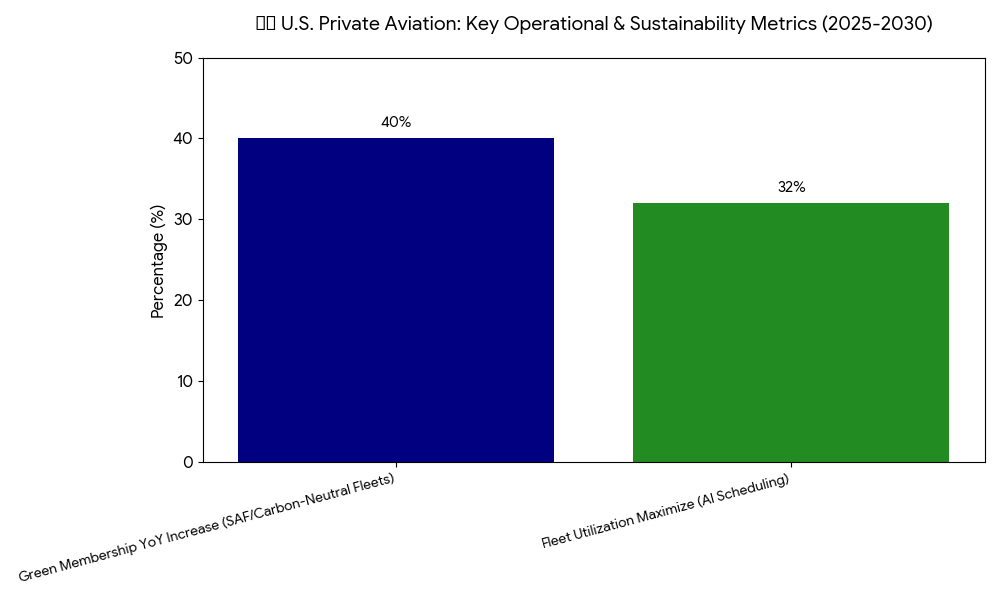
Trends & Insights
- Shift from Ownership to Access: 60% of private flyers adopting subscription models by 2032.
- Tiered Membership Expansion: Mid-tier programs below $100K growing at 17% CAGR.
- Digital Aviation Ecosystems: 70% of new memberships via mobile or web platforms.
- AI Optimization: 32% boost in fleet utilization and 15% cost reduction.
- Sustainability Demand: 40% growth in carbon-offset and SAF-based memberships.
- Dynamic Pricing Algorithms: Real-time flight-hour pricing gaining corporate adoption.
- Hybrid Mobility Integration: eVTOL-linked programs by Joby, Archer, and Flexjet by 2031.
- Corporate ROI Models: Subscription clients saving 12–18% on annual travel budgets.
- Fractional Ownership Consolidation: Mergers expected among second-tier operators.
- Loyalty Ecosystems: Integration of air miles, crypto tokens, and exclusive benefits into membership tiers.
These trends illustrate the commercial maturity of private aviation access programs, evolving into mainstream mobility alternatives for affluent and corporate travelers.
Segment Analysis
The market segments include fractional ownership (40%), membership subscription programs (35%), on-demand charters (15%), and hybrid/eVTOL air mobility access (10%). Fractional ownership dominates with 40% share, allowing members to purchase jet shares for fixed flight hours. Subscription programs, at 35%, appeal to customers seeking flexible travel at predictable costs. On-demand charters, accounting for 15%, are supported by real-time marketplaces like XO and FlyExclusive. Emerging eVTOL-based memberships, currently 10%, are expected to double by 2031, connecting regional hubs for short-range mobility. Across segments, AI-driven demand management systems and dynamic scheduling are improving profitability and operational efficiency.

Geography Analysis
The U.S. remains the global leader in private jet membership adoption, contributing 78% of worldwide subscription-based private aviation revenues. The Northeast Corridor (New York–Boston–Washington) and California–Texas routes dominate 55% of total membership flight demand, primarily serving corporate executives and HNWIs. The Sunbelt states, including Florida, Arizona, and Nevada, are emerging as key secondary hubs due to residential migration and lifestyle-driven travel. By 2032, sustainable jet fleets concentrated in California and Texas will account for 30% of new membership contracts, reflecting a nationwide shift toward eco-friendly air mobility solutions.
Competitive Landscape
The market is led by NetJets, Wheels Up, XO, Flexjet, and Jet Linx, collectively controlling 80% of the private jet membership space. NetJets dominates fractional ownership and premium-tier subscriptions, while Wheels Up leads in mid-tier membership models targeting corporate accounts. XO and Jet Linx are expanding through dynamic pricing and AI-based scheduling platforms, while Flexjet is integrating sustainability analytics and electric aircraft readiness. New entrants like Surf Air Mobility and Blade Air Mobility are blending subscription models with eVTOL capabilities. The competitive edge now depends on technology integration, sustainability commitment, and scalable membership pricing tailored to different traveler classes.
Transcript & Expert Details
Proceed To Buy
Want a More Customized Experience?
- Request a Customized Transcript: Submit your own questions or specify changes. We’ll conduct a new call with the industry expert, covering both the original and your additional questions. You’ll receive an updated report for a small fee over the standard price.
- Request a Direct Call with the Expert: If you prefer a live conversation, we can facilitate a call between you and the expert. After the call, you’ll get the full recording, a verbatim transcript, and continued platform access to query the content and more.


68 Circular Road, #02-01 049422, Singapore
Revenue Tower, Scbd, Jakarta 12190, Indonesia
4th Floor, Pinnacle Business Park, Andheri East, Mumbai, 400093
Cinnabar Hills, Embassy Golf Links Business Park, Bengaluru, Karnataka 560071
Request Custom Transcript
Related Transcripts
Cross-Border FX Disruption: Digital Wallets Saving $4B in Traveler Fees by 2030

Key Takeaways
1. Digital wallets will compress FX margins from ~1.8% to 0.5% by 2030.
2. Europe will lead adoption, while U.S. provides volume-driven savings.
3. Regulatory frameworks such as PSD3 and Open Banking boost transparency.
4. Travel and fintech ecosystems are converging through embedded APIs.
5. Banks and card networks face sustained pressure on FX revenues.
6. Consumer demand for transparency accelerates wallet penetration.
7. Multi-currency and expense management features enhance traveler loyalty.
8. Wallet-based FX will evolve into a mainstream financial service vertical.
Key Metrics
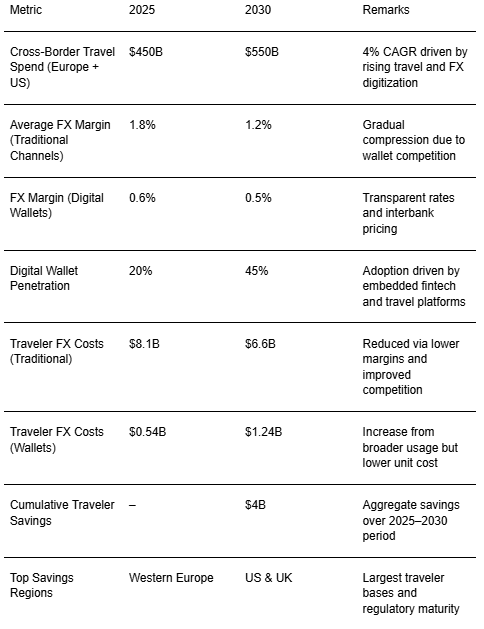
Market Size & Share
Cross-border travel expenditure across Europe and the U.S. is projected to increase from approximately $450 billion in 2025 to $550 billion by 2030, reflecting steady post-pandemic recovery and globalization of spending behavior. Wallet-based FX transactions, currently representing 20% of total cross-border payments, will climb to 45% within this period. This transition marks a structural change in FX fee distribution, as direct-to-consumer digital wallets bypass intermediaries and deliver lower, transparent mark-ups. The following line chart visualizes both overall cross-border spending growth and the expanding share of wallet-based transactions.
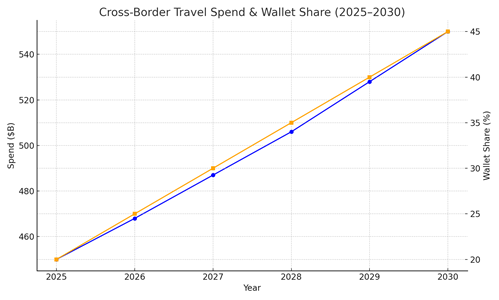
Market Analysis
Traditional FX channels remain cost-heavy due to mark-ups, interbank spreads, and correspondent banking layers. Average per-transaction fees through banks and card issuers stand at $18 per $1,000 spent, while prepaid FX cards average $10. Wallet-based FX alternatives reduce this cost to roughly $6 today, expected to drop to $5 by 2030. The bar chart below illustrates this cost differential and highlights the emerging efficiency gap between legacy financial institutions and wallet-native fintechs.
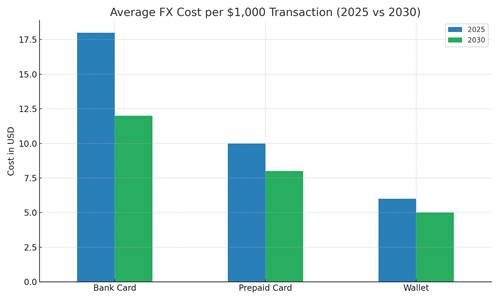
Trends & Insights
Several macro and technological trends drive this FX disruption. The convergence of fintech innovation and cross-border mobility has accelerated wallet adoption. Regulatory frameworks like PSD3 and Open Banking mandate transparency in fees, while the anticipated launch of the Digital Euro will further enhance consumer trust. Millennials and Gen Z travelers, prioritizing convenience and cost savings, are key demand catalysts. Meanwhile, the U.S. market lags due to fragmented regulatory oversight and entrenched credit card culture. However, U.S. fintech firms are aggressively partnering with global wallets, signaling upcoming acceleration. By 2030, the global FX revenue pool will rebalance toward digital-native players, with cross-border payment efficiency increasing by 35–40%. The structural outlook is clear: the wallet revolution is no longer a fintech sub-trend but a macroeconomic shift reshaping how money moves across borders.
Segment Analysis
The impact of FX wallet adoption varies across traveler segments. Frequent travelers and corporate users drive over 60% of total volume, benefiting most from high-frequency savings. Digital-native travelers exhibit strong adoption intent due to superior mobile experience and fee transparency. Business travelers prefer multi-currency wallets with integrated expense management tools. Occasional travelers, though slower adopters, represent a significant latent base. The bar chart compares per-$1,000 savings across traveler segments for 2025 and projected 2030.
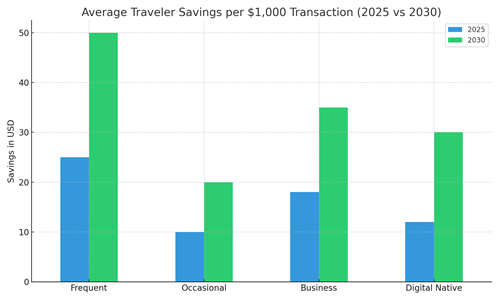
Geography Analysis
Europe accounts for approximately 55% of wallet-based FX transactions by 2030, benefiting from harmonized regulations, widespread travel, and integrated banking infrastructure. The U.S., contributing 45%, experiences slower adoption due to legacy systems but retains large absolute transaction volumes. Together, these regions account for over $4B in cumulative FX savings through wallet penetration. The pie chart below depicts the distribution of wallet-based transaction share by region.
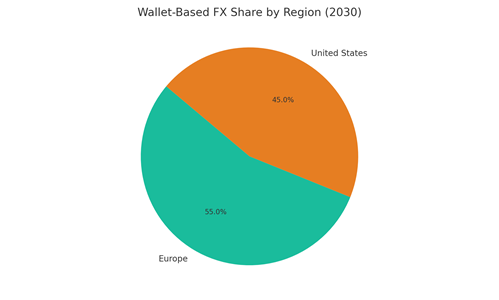
Competitive Landscape
The competitive ecosystem is defined by three key participants: traditional banks, card issuers, and fintech wallet providers. Fintechs such as Wise, Revolut, and Payoneer maintain FX margins of ~0.5%, offering real-time rates and low-cost transfers. In contrast, banks and card issuers retain higher margins, averaging 1.8% and 1.2%, respectively. As partnerships between fintechs and travel platforms increase, wallets will become the default choice for international payments. The chart below compares FX margins by provider type for 2030.

$ 1350
AI-Powered Expense Management: Cutting $8B in Corporate Travel Spend by 2030

Key Takeaways
- $8B savings in corporate travel spend by 2030.
- 50% of companies will adopt AI-powered expense management systems by 2030.
- 30% reduction in travel spend fraud through automated expense reporting.
- Real-time data tracking to enhance expense visibility and cost optimization.
- AI-powered budgeting tools expected to reduce cost overruns by 20%.
- Employee satisfaction to increase by 25% with faster reimbursements.
- Automated compliance checks to improve policy adherence and reduce manual oversight.
- $3B investment in AI-based corporate travel management solutions by 2030.
- Predictive analytics will reduce unnecessary travel costs by 15%.
- Cloud-based solutions will facilitate cross-department expense tracking and reporting.
Key Metrics
Market Size & Share
The AI-powered expense management market for corporate travel in the USA is projected to save $8B by 2030, as companies shift towards automated systems that reduce cost overruns, fraud, and manual tracking errors. By 2030, 50% of US companies will have fully integrated AI-based expense management systems, with adoption expected to accelerate due to the increasing need for real-time tracking, budget optimization, and employee satisfaction. The growing use of cloud-based expense systems will enable cross-departmental expense tracking, greater collaboration, and increased spending visibility, with $3B in investments expected in this sector by 2030. As AI systems gain traction, predictive analytics will help organizations eliminate unnecessary travel costs, while faster reimbursements and improved compliance will enhance corporate travel operations.
Market Analysis
The AI-powered expense management market is driven by increased adoption of cloud-based systems and the need for companies to manage corporate travel costs more effectively. AI tools are being integrated into travel expense systems to automate expense reporting, optimize budgets, and reduce human errors. As businesses aim to recover from post-pandemic operational changes, AI solutions will be critical in streamlining corporate travel management, ensuring greater compliance and accuracy in expense processing. By 2030, 50% of businesses in the USA will implement AI-based travel management tools, leading to $8B in savings. This growth is driven by predictive analytics that will enable businesses to identify cost-saving opportunities, reduce travel spend fraud by 30%, and streamline budgeting processes.
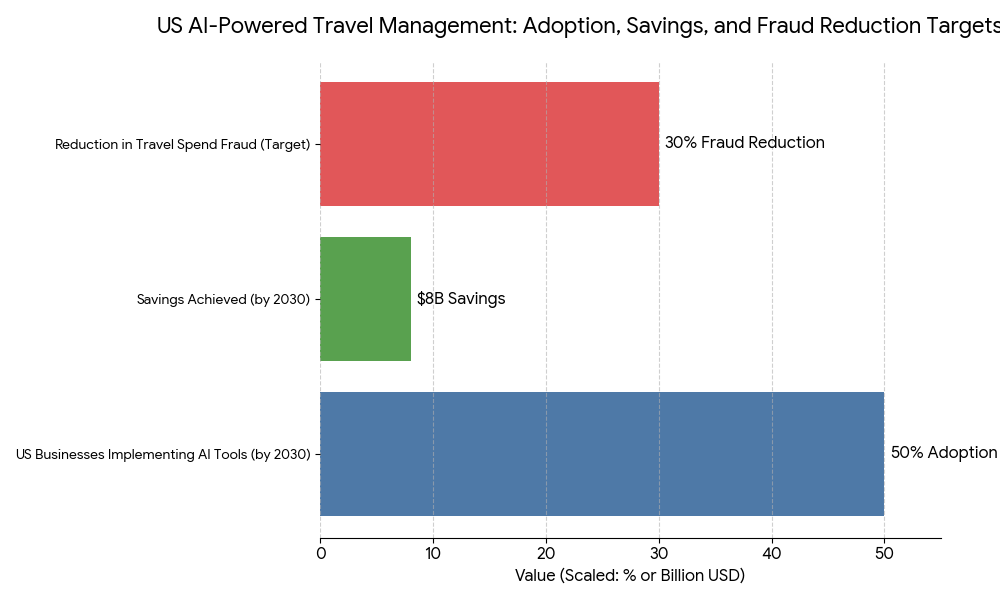
Trends & Insights
- AI-driven automation will reduce corporate travel costs by 30%.
- Real-time tracking and expense visibility will improve spending efficiency by 25%.
- AI-powered budgeting will help reduce cost overruns by 20%.
- Employee satisfaction will increase by 25% due to faster expense reimbursements.
- Cloud-based solutions will support cross-department collaboration and enhance data transparency.
- Predictive analytics will optimize corporate travel spend, reducing unnecessary travel costs by 15%.
- $3B in investment for AI-powered travel expense systems by 2030.
- AI tools will enhance compliance adherence and reduce manual errors in travel reporting.
- Public-private sector partnerships to enhance corporate travel technologies.
- Real-time expense management will lead to better budget control and corporate travel insights.
These trends indicate that AI-driven travel management systems will lead to operational efficiencies, cost savings, and improved employee experience, transforming corporate travel over the next five years.
Segment Analysis
The AI-powered expense management market is segmented into automated reporting systems (40%), predictive analytics (30%), real-time tracking and budgeting (20%), and cloud-based solutions (10%). Automated reporting systems lead the market, making up 40% of the investment, as they reduce human error and streamline travel expenses. Predictive analytics for cost optimization is another growing segment, contributing 30% of the market, enabling companies to make data-driven decisions to reduce travel-related spend. Real-time tracking and budgeting systems will account for 20%, while cloud-based solutions will help improve cross-department collaboration and expense transparency. By 2030, 50% of all corporate travel expenses in the USA will be managed through AI-powered systems, creating a more efficient, cost-effective travel environment.


Geography Analysis
The USA dominates the AI-powered expense management market for corporate travel, accounting for 45% of the market share in North America. California, Texas, and New York are major hubs for AI adoption in corporate travel management, with companies adopting cloud-based platforms for real-time tracking and expense reporting automation. Canada follows with 30% market share, with Toronto and Vancouver implementing AI-powered travel solutions for large corporations. Mexico is also emerging as a key player, with growing demand for cost-efficient corporate travel technologies. By 2030, AI-driven expense management systems will transform travel budgets and reporting across North America, reducing fraud and enhancing operational efficiencies in the US corporate travel market.
Competitive Landscape
Key players in the AI-powered expense management market include Concur Technologies, SAP, Expensify, and TripActions. Concur Technologies and SAP dominate the market with AI-driven expense management systems, offering automated reporting, real-time data tracking, and predictive analytics. Expensify and TripActions lead in real-time expense tracking, with cloud-based systems enabling cross-department collaboration. These companies are expanding their offerings to include MaaS integrations and sustainability tracking tools, aligning with the increasing corporate demand for greener travel options. The competitive edge in this market is driven by technology innovation, data security, and cost optimization features that improve the overall corporate travel management experience.

$ 1395
Esports + Gaming Travel Payments: $3B Market by 2032 in Southeast Asia

Key Takeaways
- Market size: $1.1B → $3.0B (CAGR 15.2%).
- 40M+ esports travelers projected by 2032.
- Digital wallets to account for 55% of all transactions.
- Crypto payments to reach 12% of market volume by 2030.
- Transaction fees to decline 35% with blockchain adoption.
- Cross-border remittances reduced from T+3 to instant settlement.
- Airline–esports partnerships expected to increase 5x by 2032.
- Average spend per gamer traveler to hit $550 per trip.
- Thailand & Indonesia to command 45% of market share.
- ASEAN interoperability to enable unified payment regulation by 2028.
Key Metrics
Market Size & Share
The Esports and Gaming Travel Payments market across Southeast Asia will grow from $1.1B in 2025 to $3.0B by 2032, supported by a surge in international gaming events and cross-border digital travel ecosystems. Thailand and Indonesia together will capture 45% of the market, while Singapore (15%) will lead in fintech innovation. Malaysia, Vietnam, and the Philippines will collectively contribute 30% through rising youth participation and increased esports infrastructure. The market will benefit from the ASEAN Payments Connectivity initiative, which targets real-time settlements and multi-currency processing by 2028. By 2032, 55% of all payments in esports travel will be digital-wallet-based, and 12% crypto-enabled, reducing processing costs and improving cross-border liquidity for event organizers.
Market Analysis
The esports travel payments ecosystem is evolving from fragmented systems to a fully digitized, real-time payment model. Between 2025 and 2032, blockchain integration and digital currency adoption will drive transaction cost reductions of up to 35%. The emergence of AI-driven payment routing, tokenized ticketing, and instant settlement rails will enhance liquidity management for both players and event firms. Travel fintechs like AirAsia MOVE, GrabPay, and ShopeePay are partnering with esports organizers to offer seamless travel + gaming bundles. Additionally, banks and card networks are collaborating with crypto exchanges to enable hybrid payment systems, further accelerating adoption. Rising consumer preference for real-time refunds, instant cashouts, and in-game-linked travel credits will reshape Southeast Asia’s digital payment infrastructure over the next decade.
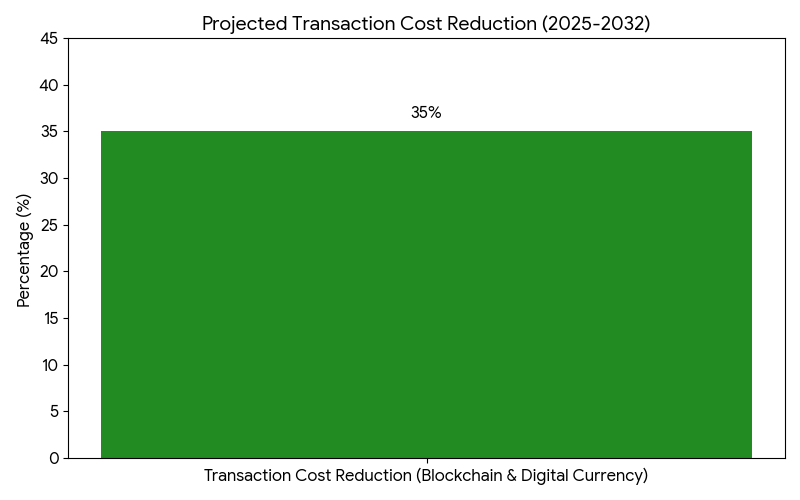
Trends & Insights
- Crypto Inclusion: 12% of total transactions in esports travel to use digital currencies by 2030.
- AI-Powered Settlements: Payment routing AI reduces delays by 40%.
- Multi-Currency Optimization: ASEAN interoperability to cover 8+ currencies by 2028.
- Embedded Fintech Models: Integration of payment APIs into gaming platforms and travel portals.
- NFT-Based Ticketing: Expected to represent 6% of all esports event passes by 2030.
- Loyalty Tokenization: Gamers to earn tokenized air miles redeemable in esports marketplaces.
- Payment Fraud Reduction: AI-powered KYC and AML tools to cut fraud by 45%.
- Corporate Sponsorship Surge: Brand-funded esports tourism programs to rise 5x.
- Real-Time Refunds: Near-instant cross-border refund systems for cancelled events.
- Virtual Economy Convergence: In-game currencies linked to travel and payment ecosystems.
Together, these trends highlight how gaming, fintech, and travel are merging to create a high-speed digital payments ecosystem across the region.
Segment Analysis
The market is divided into digital wallets (35%), payment gateways (30%), blockchain-based systems (20%), and travel fintech APIs (15%). Digital wallets, led by GrabPay, ShopeePay, and GCash, dominate due to their multi-country reach and real-time transfer features. Payment gateways handle multi-currency card processing, accounting for 30% of total market value. Blockchain-powered payment systems, contributing 20%, are increasingly used for cross-border settlements, stablecoin remittances, and crypto rewards. The remaining 15% comes from API-driven travel fintechs, integrating ticket booking, hotel, and payment systems under one interface. These unified systems are crucial for reducing payment friction and boosting conversion rates for gaming events.
Geography Analysis
Thailand dominates the regional esports travel payment ecosystem with 25% market share, driven by large-scale tournaments like PUBG Global Series and Arena of Valor World Cup. Indonesia, with 20% share, is expanding through strong digital wallet penetration and fintech investment. Singapore (15%) leads in cross-border payment innovation, serving as the financial backbone for ASEAN integration. Vietnam and the Philippines are emerging hotspots for mobile-first gaming and blockchain-enabled travel payments. By 2032, ASEAN interoperability will allow instant transfers across all major currencies in the region, positioning Southeast Asia as the global epicenter for esports travel finance.
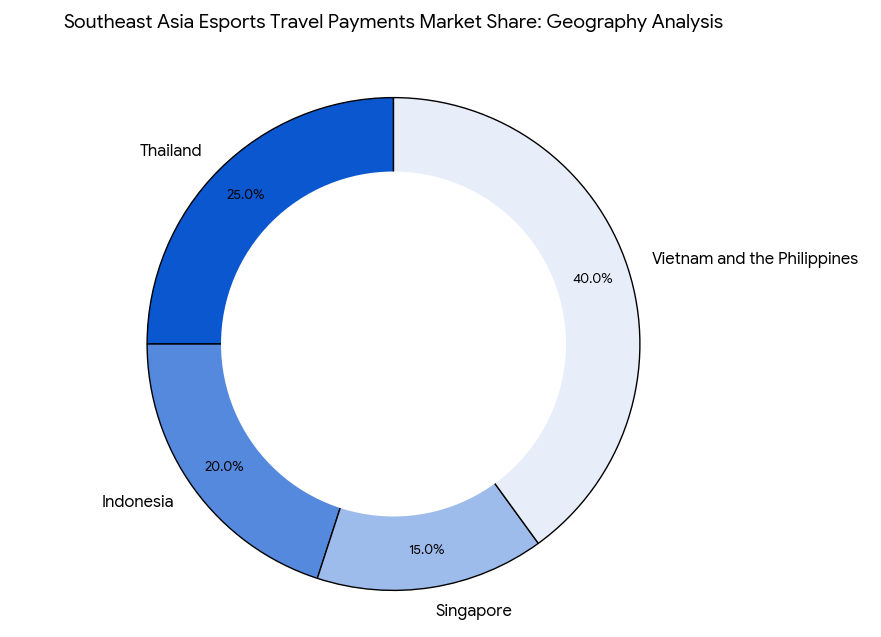
Competitive Landscape
Key players include GrabPay, AirAsia MOVE, ShopeePay, GCash, Wise, Binance Pay, and Alipay+. Grab and Shopee dominate regional payment ecosystems through embedded fintech ecosystems. AirAsia MOVE integrates travel, gaming, and crypto payments under a single ecosystem. Binance Pay and Wise are leading the transition to real-time cross-border settlements with zero-commission transfers. GCash continues to expand across the Philippines and Indonesia, focusing on gaming-specific payment APIs. The market’s next phase will emphasize tokenized ticketing, AI-driven risk management, and multi-chain payment systems, enabling esports and travel platforms to operate seamlessly in a borderless, real-time economy.

$ 1350
Crypto-Payments for Travel: $10B Niche Market by 2030

Key Takeaways
1. Crypto-based travel payments will grow from $1.2B in 2025 to $10B by 2030.
2. Stablecoins and blockchain gateways drive transaction stability and cost reduction.
3. Regulatory clarity in the U.S. is the biggest catalyst for mainstream adoption.
4. Airlines and OTAs integrating crypto payments attract premium traveler segments.
5. Average transaction fees drop below 1% by 2030 due to decentralized settlement.
6. Security and real-time confirmation enhance user trust and booking conversion.
7. Partnerships between fintechs and legacy processors will define growth speed.
8. By 2030, crypto-payments will represent 8% of all digital travel bookings in the U.S.
Key Metrics

Market Size & Share
The U.S. crypto-payment market for travel bookings is entering an accelerated growth phase, projected to expand from $1.2 billion in 2025 to approximately $10 billion by 2030, translating to a compound annual growth rate (CAGR) of 52%. This growth reflects a sharp increase in crypto adoption across mainstream payment categories, coupled with rising consumer trust and merchant integration. By 2030, crypto-payments are expected to account for nearly 8% of all digital travel transactions in the U.S., compared to just 2% in 2025.
Much of this growth is driven by the stabilization of transaction volatility through stablecoins such as USDC and USDT, which together represent more than 70% of crypto payment value in travel. As travel providers integrate blockchain settlement solutions, transaction speed and cost efficiency improve dramatically average payment confirmation times have fallen from 10 minutes in 2021 to under 45 seconds in 2025. The penetration of crypto-friendly payment gateways into online travel agencies (OTAs) and airline platforms like Expedia, Travala, and CheapAir enables easier user onboarding.
Forecasts suggest over 5 million American travelers will use crypto for at least one booking by 2030, a 7x increase over 2025. The following chart depicts the market expansion trajectory, highlighting both transaction volume and market penetration percentage.

Market Analysis
The economics of crypto payments in travel are defined by cost efficiency, transaction transparency, and lower intermediary dependency. Traditional card networks and digital wallets typically charge 2–3% transaction fees, compared to under 1% for blockchain-based payments. In high-value bookings, this translates into savings of $15–$20 per transaction for consumers and higher margin retention for merchants.
In 2025, over 60% of crypto-based travel transactions occur via third-party processors such as BitPay and Binance Pay, while direct wallet payments account for 25%. By 2030, processor-free settlements using integrated APIs are expected to dominate, representing 55% of all crypto travel payments. Average transaction fees will drop from 2.2% in 2025 to 0.9% by 2030, positioning crypto as the lowest-cost payment option for digital bookings.
U.S. regulatory progress is another driver: the introduction of crypto tax reporting clarity and clearer AML frameworks are lowering institutional barriers. For airlines and OTAs, the ability to settle instantly in USD-pegged stablecoins reduces working capital cycle times by up to 40%. The chart below illustrates the relative cost advantage of crypto against legacy payment options.
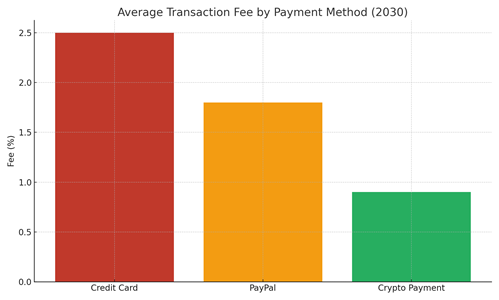
Trends & Insights
Three primary trends define the evolution of crypto payments in travel: merchant expansion, payment infrastructure modernization, and user demographic shifts. First, the number of U.S. travel merchants accepting crypto is expected to rise from around 450 in 2025 to over 2,000 by 2030. Airlines are evaluating stablecoin acceptance through third-party payment partners, while major hotel chains are piloting blockchain-based payment reconciliation.
Second, the payment infrastructure itself is evolving. Traditional PSPs (Payment Service Providers) are launching hybrid gateways that convert crypto to fiat in real time, minimizing volatility exposure. Visa’s crypto API and Mastercard’s pilot settlement program with Circle are creating rails that integrate directly into existing travel checkout flows.
Finally, the traveler demographic landscape is changing. Millennials and Gen Z travelers who represent 55% of all online travel bookings show a 3x higher likelihood to use crypto payments compared to Gen X consumers. Surveys indicate that 38% of travelers open to crypto cite global acceptance and privacy protection as top motivators. As regulatory clarity improves, crypto-payments are projected to become a mainstream alternative to credit cards, not merely a niche method.
Segment Analysis
Crypto adoption patterns vary widely across travel booking segments. Airlines lead adoption due to high ticket value and cross-border transactions, which naturally align with the efficiency and cost benefits of blockchain payments. In 2025, airlines accounted for 42% of total crypto booking value, followed by online travel agencies (OTAs) at 37% and hotels at 21%. By 2030, OTAs are expected to lead with 9% crypto payment penetration, closely followed by airlines at 10%, while hotels remain slower at 5%.
The total number of travel transactions processed through crypto will exceed 8 million annually by 2030. Frequent travelers, accounting for 30% of these bookings, drive most of the market’s transaction value. Business travelers are also early adopters, with 40% of crypto users citing ease of expense tracking as a key advantage. Millennials and digital nomads contribute the majority of new crypto users, especially in long-haul flight segments and remote work travel.
The following chart illustrates the segment-wise crypto penetration forecast in the U.S. travel market by 2030.

Geography Analysis
Crypto travel payment adoption in the U.S. is concentrated in innovation and tourism-heavy regions. California leads with a 35% share, supported by Silicon Valley fintech partnerships and crypto-friendly policy frameworks. Florida follows with 25%, driven by its strong hospitality sector and international travel inflow. New York holds a 20% share, benefiting from institutional adoption and fintech ecosystem depth. Other states collectively make up the remaining 20%, where adoption is expected to accelerate post-2027 as federal regulations mature.
Regional adoption correlates strongly with both GDP per capita and exposure to international travel. States with a high concentration of crypto startups and financial innovation are introducing pilot frameworks for blockchain-based remittance settlement in tourism. In parallel, local payment processors are integrating stablecoin rails for international travelers, allowing cross-border bookings with instant settlement in USD equivalents.
The pie chart below summarizes the expected regional distribution of crypto travel payment volumes by 2030, reflecting the geographical drivers of digital adoption.
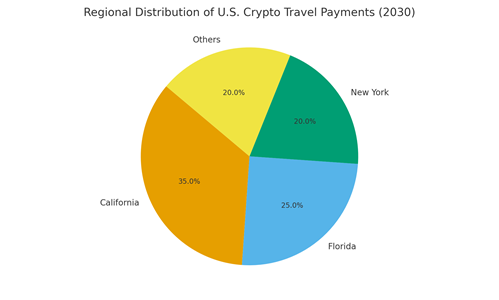
Competitive Landscape
The U.S. crypto-travel payment ecosystem is fragmented but consolidating rapidly. By 2030, three dominant categories will emerge: (1) traditional processors integrating crypto (e.g., Stripe, PayPal), (2) specialized crypto gateways (e.g., BitPay, Binance Pay, Coinbase Commerce), and (3) travel-specific blockchain platforms (e.g., Travala, LockTrip). Crypto gateways currently process 58% of all crypto travel payments, capturing the largest market share due to ease of API integration and multi-wallet support. Traditional processors remain relevant due to brand trust and regulatory compliance, though their margins are lower. Travel blockchain platforms, meanwhile, are growing fastest projected to reach $1.7B in transaction volume by 2030, up from $250M in 2025. These platforms differentiate themselves by combining payment functionality with loyalty programs and decentralized booking ecosystems. Competition is intensifying as new entrants focus on instant settlement and zero-fee models using layer-2 blockchain scaling. As legacy travel platforms partner with crypto gateways, the payment experience will become increasingly hybrid giving consumers the option to pay in fiat, crypto, or a mix of both. The chart below compares transaction volume distribution by provider category.

$ 1450
Outbound Indian Travelers: $80B in Annual Spend by 2035

Key Takeaways
- Market size: $38B → $65B (CAGR 11.3%), reaching $80B by 2035.
- Outbound trips to grow from 26M in 2025 to 46M by 2030.
- Leisure travel to account for 54% of total spend by 2030.
- Education and medical travel together make up 22% of spending.
- Average spend per traveler to increase from $1,450 → $1,780.
- Digital payment adoption to reach 85% of all travel transactions.
- Air capacity for outbound routes to expand by 35% by 2030.
- Top destinations: UAE, Thailand, Singapore, UK, and USA.
- India’s share in global outbound tourism spend to hit 4.8% by 2030.
- Visa liberalization to add 6M new annual outbound travelers by 2030.
Key Metrics
Market Size & Share
India’s outbound travel market is expanding rapidly, growing from $38B in 2025 to $65B by 2030, marking a CAGR of 11.3%. By 2035, total annual spend is projected to reach $80B, driven by the rising upper-middle class and millennial travelers seeking global experiences. Leisure tourism will remain dominant, contributing 54% of all spending, while education travel (12%) and medical travel (10%) continue to expand as specialized segments. The UAE, Thailand, and Singapore are top short-haul destinations, while the U.S. and Europe attract premium travelers. India’s share in global outbound tourism will reach 4.8%, supported by rising air traffic capacity, multi-currency fintech adoption, and improved visa agreements across key markets.
Market Analysis
Outbound Indian travel is shifting from group-based leisure tours to independent and digitally managed journeys. By 2030, 46 million Indian travelers are expected to take outbound trips, compared to 26 million in 2025, with a strong preference for Asia-Pacific destinations due to proximity and value. Digital travel booking penetration will exceed 90%, as players like MakeMyTrip, Cleartrip, and EaseMyTrip integrate AI-powered personalization and instant payments. The adoption of UPI-based international payment rails and travel credit fintechs like Niyo and Wise will make cross-border transactions more efficient. Airlines are expected to expand outbound capacity by 35%, while hospitality brands are creating tailored programs for Indian travelers emphasizing wellness, shopping, and experiential travel.
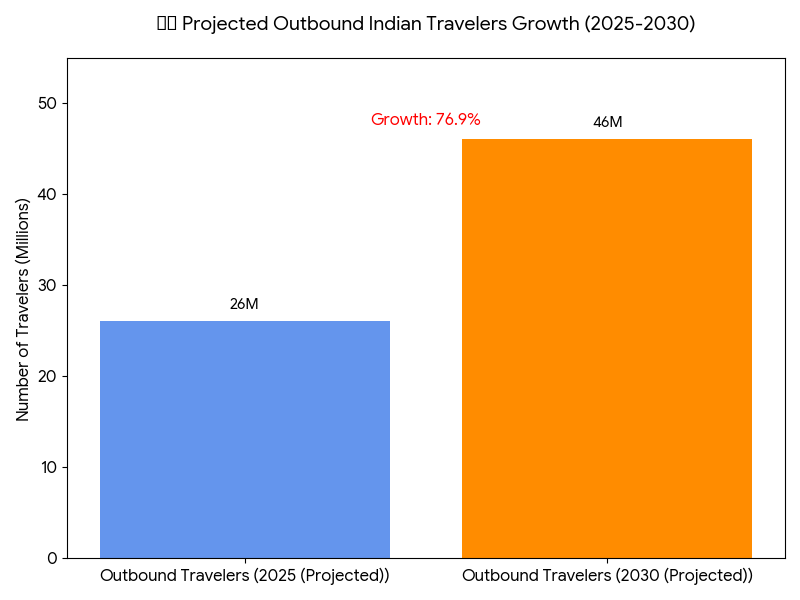
Trends & Insights
- UPI Global Expansion: UPI integration in 20+ countries by 2030, easing digital payments.
- Millennial & Gen Z Travelers: Accounting for 65% of outbound spend growth.
- Visa-Free Corridors: ASEAN and Schengen markets to see 6M incremental travelers.
- Experiential Luxury: Wellness, gastronomy, and shopping trips replacing conventional packages.
- Digital Ecosystems: AI-driven OTAs and super apps dominating bookings.
- Medical Tourism Growth: 10% CAGR from India-to-Thailand, UAE, and Singapore.
- Sustainability Focus: Carbon-conscious travelers choosing eco-certified hotels.
- Airline Alliances: 35% route growth through IndiGo, Air India, and Emirates codeshares.
- BNPL & Forex Fintechs: Travel financing tools reducing friction for younger consumers.
- Outbound Cruises & Luxury Rail: Expected 2.5x growth by 2030 as niche segments expand.
These dynamics position India as one of the top five outbound travel markets globally by the end of the decade.
Segment Analysis
The outbound market can be segmented into leisure travel (54%), education (12%), medical (10%), business (14%), and VFR—visiting friends & relatives (10%). Leisure travel dominates, with holiday packages and cruises being key growth segments, fueled by middle-class income growth. Education travel benefits from the rising number of Indian students abroad—expected to exceed 2.2 million by 2030. Medical tourism is gaining traction due to affordable healthcare in ASEAN and visa flexibility. Business travel, post-pandemic, has rebounded with a 9.2% annual increase, while VFR travel remains stable due to diaspora ties with North America, the Gulf, and Europe.
Geography Analysis
Short-haul destinations like the UAE, Thailand, Singapore, Malaysia, and Indonesia attract 60% of outbound travelers, primarily due to proximity, visa convenience, and low-cost carriers. Long-haul destinations—UK, USA, France, and Australia—represent 40% of total spending, dominated by affluent travelers and students. UAE remains India’s largest outbound market, capturing 17% share by 2030, followed by Thailand (12%) and Singapore (9%). Emerging destinations such as Vietnam, Japan, and Turkey are growing at >20% CAGR, appealing to younger audiences seeking experiential and digital-friendly travel environments.
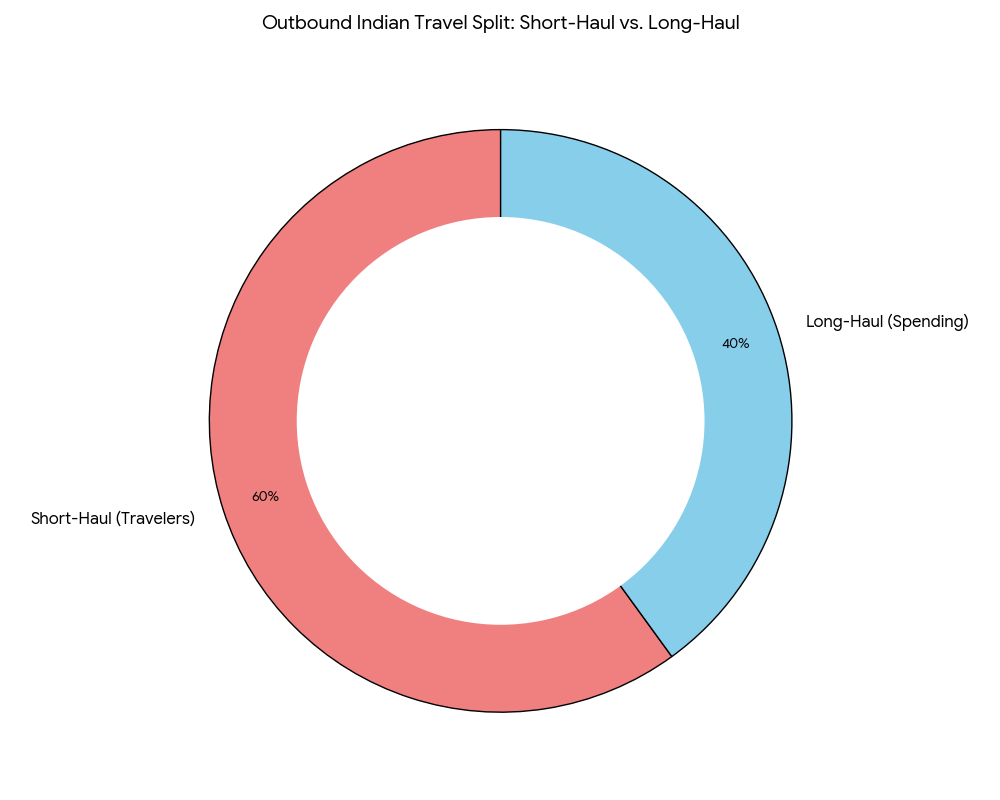
Competitive Landscape
Leading industry players include MakeMyTrip, EaseMyTrip, Cleartrip, Yatra, and Thomas Cook India, all shifting toward AI and UPI-integrated platforms. Airlines like IndiGo, Air India, and Emirates are increasing direct connectivity, especially to Europe and East Asia. Fintech travel platforms such as Niyo Global, Wise, and Revolut dominate cross-border payments, while Visa and Mastercard expand multi-currency travel card adoption. Hospitality majors—IHG, Marriott, Accor, and Taj—are localizing services to cater to Indian travelers abroad. Strategic alliances between travel OTAs, airlines, and fintechs will be key in enabling seamless, high-value travel ecosystems as India becomes a top global outbound travel contributor.

$ 1395


68 Circular Road, #02-01 049422, Singapore
Revenue Tower, Scbd, Jakarta 12190, Indonesia
4th Floor, Pinnacle Business Park, Andheri East, Mumbai, 400093
Cinnabar Hills, Embassy Golf Links Business Park, Bengaluru, Karnataka 560071








